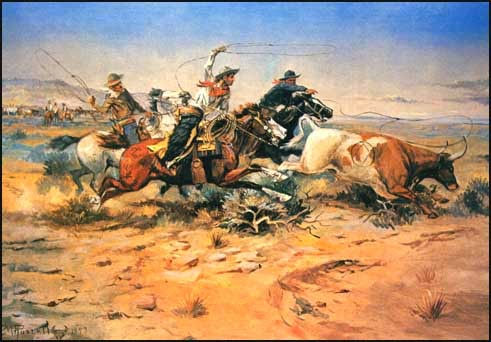Article: The Hawaiian Paniolo (Cowboy) Ikua Purdy
- Philip Waikoloa

- 10 de jul. de 2019
- 3 min de leitura

Painting: C. Russell
The gift of a few cattle, given to Kamehameha I by Captain George Vancouver in 1793, spawned a rich tradition of cowboy and ranch culture that is still here, today.
With a kapu against killing the cattle, by 1830, wild bullocks posed a serious and dangerous threat to humans. Spurred also by the growing business of reprovisioning visiting ships with fresh meat and vegetables, Kamehameha III and Kaʻahumanu saw the wisdom of bringing in experienced cowboys.
They hired Spanish-Mexican vaquero (cowboys) from California to hunt bullocks and train Hawaiians to rope and handle cattle. The cowboys spoke Spanish – “Espanol” which turned into “paniolo” according to one explanation of the term.
The Hawaiian cowboy, nicknamed “paniolo,” played an important role in the economic and cultural development of Hawaiʻi and helped to establish the islands as a major cattle exporter to California, the Americas and the Pacific Rim for over a century.
Some might not realize that Hawaiʻi’s working paniolo preceded the emergence of the American cowboy in the American West.
After winning the Revolutionary war (1781), American settlers started to pour into the “west;” by 1788, the first permanent American settlement in the Northwest Territory was in Ohio.
In 1800, the western frontier extended to the Mississippi River, which bisects the continental United States north-to-south from just west of the Great Lakes to the delta near New Orleans.
Then, in 1803, President Thomas Jefferson’s Louisiana Purchase doubled the size of the nation.
The Battle of the Alamo was in 1836; later that year, Texas became independent, the Mexicans left, leaving their cattle behind. Texan farmers claimed the cattle and set up their own ranches.
It wasn’t until the 1840s that the wagon trains really started travelling to the far west. Then, with the US victory in the Mexican-American war and gold soon found in California, the rush to the West was on.
The cattle trade in the American West was at its peak from 1867 until the early-1880s.
And, when in cattle country, you can expect rodeos.
Headlines in Island and Wyoming newspapers in August of 1908 announced rodeo history.
Twelve thousand spectators, a huge number for those days, watched Ikua Purdy, Jack Low, and Archie Kaaua from Hawaiʻi carry off top awards at the world-famous Cheyenne Frontier Days Rodeo (the “granddaddy” of rodeo.).
Unlike today’s calf-roping, riders lassoed powerful, full-grown steers.
The Cheyenne paper reported that the performances of the dashing Hawaiians, in their vaquero-style clothing and flower-covered, “took the breath of the American cowboys.”
Under drizzling skies, Purdy won the World’s Steer Roping Championship—roping, throwing and tying the steer in 56 seconds. Kaaua and Low took third and sixth place.
They each accomplished these feats on borrowed horses.
Purdy worked at Parker Ranch prior traveling to Cheyenne, Wyoming; his victory demonstrated the exceptional skills of the paniolo to mainland cowboys who long regarded rodeo and roping as their own domain.
On arriving home, the men were met at dockside by thousands of cheering fans and also honored by parades and other festivities on Maui and Hawai‘i.
Waimea-born Purdy moved to Ulupalakua, Maui and resumed his work as a paniolo until his death in 1945. He did not return to the mainland to defend his title, in fact he never left Hawaii’s shores again. But his victory and legend live on in Hawaiʻi and the annals of rodeo history.
In 1999, Ikua Purdy was voted into the National Cowboy Museum, Rodeo Hall of Fame. That same year he was the first inductee to the Paniolo Hall of Fame established by the Oʻahu Cattlemen’s Association.
In 2003, a large bronze statue of Purdy roping a steer was placed in Waimea town on the Big Island, erected by the Paniolo Preservation Society. In October 2007, Purdy was inducted into the Cheyenne Frontier Days Hall of Fame.
Follow Peter T Young on Facebook








































Comentários